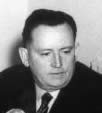 |
|||||||||
'From precedent to precedent': Cartoon Interpretation
Cartoon by Ted Scorfield published in the Bulletin, 2 February 1944.
Click on the cartoon below to see a larger image.
FROM
PRECEDENT TO PRECEDENT.
"This agreement... shall come into force as soon as both Governments
have ratified [it] and have satisfied each other accordingly."
- Last clause of the Australia - N.Z. agreement signed at Canberra.
Context
Before you try the guided interpretation activities, here's some useful contextual information that will help you understand the political situation in Australia leading up to the signing of the Anzac Agreement in early 1944. There's also some background about the cartoonist and the newspaper that carried the cartoon.
- In 1931 the British Parliament passed the Statute of Westminster establishing Australia as an independent state, able to form its own foreign policy and defence, free from British control.
- Initially, Australia, unlike Canada and South Africa, made no attempt to ratify the five key sections of the Act which required separate Australian action.
- The decision of the Curtin Government to legislate for parliamentary ratification of the Statute of Westminster in the second half of 1942, was a major step forward in Australia’s preparedness to forge its own legal identity in the international arena. The first opportunity came in early 1944.
- Australia was angry that the Allies had met in December 1943 and, without consultation or the provision of much information, had decided on issues of importance to the Pacific region.
- These decisions included stripping Japan of all her conquests, restoring to China territories taken by Japan and restoring to European powers their former territories in the Pacific.
- New Zealand shared Australia’s concern about the lack of consultation but it was Australia that took the initiative by arranging a conference between the two nations and then put forward the suggestion of a treaty.
- Through the Australian-New Zealand Agreement of 1944, Australia and New Zealand unilaterally stated their right to share in discussions about the South-West and South pacific area.
- Under this agreement Australia and New Zealand agreed to consult and work together on matters such as: security and defence, post war disposal of territories and bases, and, the welfare of Pacific people.
- The Australian cabinet ratified the agreement on 24 January
1944 and New Zealand on
1 February. - This was the first time that Australia had entered into an international agreement to which Britain was not a party.
- The agreement was generally welcomed by the UK government and the British press. It received an unsympathetic hearing in the United States.
- The agreement can also be considered the forerunner of the ANZUS treaty signed between Australia, New Zealand and the United States in 1951.
The Cartoonist:
Born Northumberland, England, 1882, died Mosman, New South Wales 1965.
Edward Scafe Scorfield served in the Royal Engineers during World War
One, serving at Gallipoli, Salonika, Greece and Palestine. After the war,
he began drawing cartoons for the Newcastle Weekly
Chronicle before coming to Australia to work for the Bulletin
as a cartoonist and illustrator in 1925. His cartoons followed the Bulletin
line of the time, combining Australian nationalism and British conservatism.
In World War Two, Scorfield's cartoons 'lionised the Digger, exalted the
Allies against the Japanese, and lampooned black-marketeers, strikers
and white feather conchies.' Scorfield stayed with the Bulletin
until 1961.
Information from biography of Ted Scorfield by
Peter Coleman in the Australian Dictionary of Biography, Volume 16, pp
197-8
Publisher: The Bulletin described itself in the 1940s as 'The national Australian newspaper' with the rider 'Australia for the white man'. It was generally pro-private enterprise, anti-union and against any moves to socialise industry. The Bulletin's editorial of 2 February 1944 gave a comprehensive and favourable analysis of the Anzac Agreement, even though the accompanying cartoon looked at the treaty more light heartedly. In the war years the Bulletin was particularly supportive of the Australian fighting male, including a lot of humour about Aussi soldiers and the Australian way of life in its articles and cartoons.
Check your understanding of this contextual information- What important meeting took place in Australia around January 1944?
- What were the circumstances leading to this meeting?
Interpretation Activity 1
| Focus on | Maori carved pole |
| grass and bare feet |
Interpretation Activity 2
| Focus on | the third character from the right |
| all the remaining characters |
- Who does this character represent? Answer
- How does the cartoonist identify this character as an Australian? Answer
Interpretation Activity 3
| Focus on | all the remaining characters |
- The following people attended the Australian-New
Zealand conference of 1944 - use the photos to help identify as many
of the cartoon characters as possible.

John Curtin, Prime Minister of Australia and Minister for Defence. (image JCPML00036/13)

John Dedman, Minister for War Organisation of Industry. (image JCPML00438/3)

Peter Fraser, Prime Minister of New Zealand. (image JCPML00376/16)

Herbert Evatt, Attorney General and Minister for Foreign Affairs, architect of the Anzac Agreement. (image JCPML00376/102)

Frank Forde, Deputy Prime Minister and Minister for the Army. (image JCPML00409/6)
Answer
- What do both the characters on the left hold in their right hand? Answer
- In what other way do the two characters on the left differ from those on the right? Hint
- Which character in the cartoon seems to be the driving force in the dance? Identify this character? Hint
- The character third from the left is making a 'V' symbol with his fingers. What does this signify? Hint
- What do you notice about the way the characters are dressed? Answer
Interpretation Activity 5
| Focus on | caption 'FROM PRECEDENT TO PRECEDENT' |

